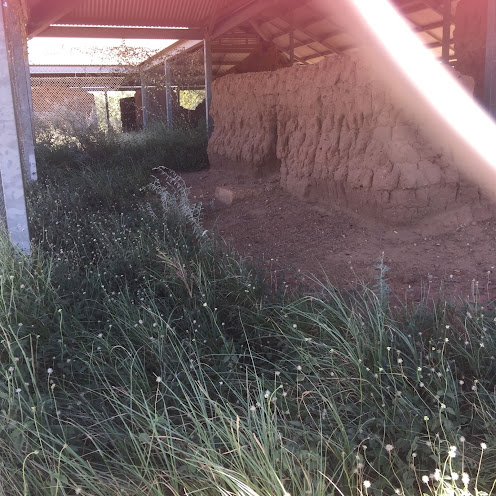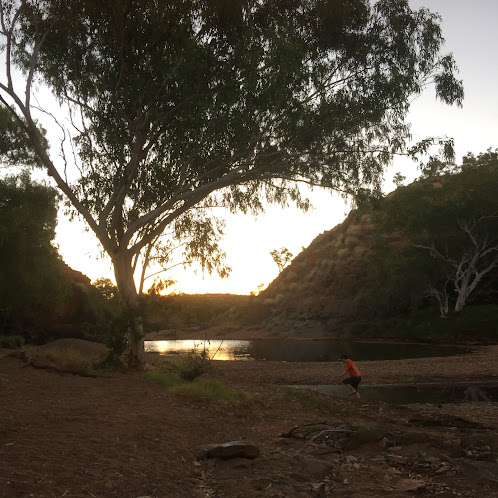Land around Halls Creek has long been inhabited by the Jaru, Kija, Kukatja, Walmajarri, and Gooniyandi people. Today it known for the discovery of gold, and the stories of Aboriginal elder Jack Jugarie and gold miner Russian Jack.
We didn't spend a lot of time in town, we didn't feel very comfortable with the locals yelling and cursing. We did go to the information centre to find out about the local roads, especially the road to Wolf Creek.
We drove down Duncan Road, past China Wall and Carolines Pool to the old original town site now known as Old Halls Creek, now only a few ruins with information boards. We loved the old car bonnets with painted murals at the different sites.


There was one substantial ruin under cover to help prevent further weathering, which shows what the other swellings would have looked like.
We chose to stay at Old Halls Creek on a property at $10 a night. We felt safe and the view was amazing.

Halls Creek is named after Charlie Hall, who found a huge 28 ounce (almost a kilo) gold nugget at the site on Christmas Day 1885, the first payable gold found in Western Australia. This discovery lead to the Kimberley Gold Rush and more than 15,000 prospectors coming to the area. The first European to explore the area was Alexander Forrest in 1879 who reported that the land was good for grazing cattle and that gold may be found in the area. Forrest again visited the area in 1883 and the expedition included a geologist, Hardman, who suggested several sites that he thought may have gold. Charles Hall and Jack Slattery sailed from Roebourne near Karratha to Derby early 1885 and travelled along the tracks made by the Forrest party. After the discovery of gold the shanty town grew. Many hazzards were encounted by the prospectors both travelling to the area and prospecting. The harsh conditions and lack of fresh water, not to mention the threat of crocodiles, made many give up and those who stayed were subjected to disease. It is not known how many died during this time as no records were kept. The town had two hotels, a post office, butchers and many humpies.

The gold rush only lasted a few years as life there was so hard and when the gold rush started in Coolgardie in 1892, many prospectors moved there. During the great depression many men who had no money or work decided to try their luck and searched for gold. An accident in Halls Creek on 29th July 1917 led to the founding of the Flying Doctors. Stockman Jim Darcy was mustering stock about 50km south of Halls Creek, when his horse stumbled throwing Darcy onto ground. Darcy lay on the ground several hours until he was found and had to be transported back to the station. It was a bumpy ride in the back of a flat tray wagon, and with no one available to treat his injuries, he was taken again by wagon on a 12 hour journey to Halls Creek. Back in 1917 there was no hospital or even a doctor, so the post master Fred Tuckett who had a limited medical knowledge administered morphine for the pain. Doctors in both Wyndham and Derby were away from town so Tuckett telegraphed Dr Joe Holland in Perth who did a diagnosis by telegraph and then instructed the postmaster to perform an operation on Darcy's ruptured bladder. Dr Holland checked the healing progress of Darcy, and when he appeared to deteriorate the Dr decided he should attend in person. He travelled over 3,700km by cattle boat to Derby and then by road, taking two weeks. When he arrived at Halls Creek, he was a day too late. Darcy died the day before as a result of complications and malaria. A Presbyterian Minister, Rev. John Flynn recognised the need for better medical facilities in the outback. This led to the establishment of an Inland Mission Hospital at Halls Creek in 1918.

Flynn had already established many out back hospitals and had a vision for the use of radios and aircraft to provide much needed medical services, and the Flying Doctors was born.
James Darcy is buried at Old Halls Creek Cemetery.
In 1955, Halls Creek was relocated 15 km west to the main road. The
next day we left the van at Old Halls Creek and drove the Tanami Road the long distance of
300 kms return, to Wolf Creek. We could have taken the van and stayed
the night, but I've seen the start of the movie 'Wolf Creek' and we were
not going to spend a night there. The roads were unsealed and it was very slow travelling along them. It took us over 3 hours each way along the Tanami Road. The Tanami Road is part of the Canning Stock Route.
The
Canning Stock Route runs through Halls Creek, south west to Wiluna
and is a 4wd track only. Travelling across the Gibson Desert and the
Great Sandy Desert, the Canning Stock Route is the longest stock route
in the world stretching 2,013km. The route was surveyed in 1906/7 by
Albert Canning and between 1908 and 1909, 51 wells were constructed
along the route.
Turning
off the road and into the Wolf Creek Crater National Park we had a
couple of gates to open and close, and drove past what looked like an
old farm house with graffiti and cattle all over the place.
The Wolf Creek Crater is on the edge of the Great Sandy Dessert, and was formed by a meteorite that hit the earth over 300,000 years ago. It is believed to be the second largest crater in the world and is 880m across and about 60m high. The center is mostly gypsum and has many trees, and sink holes.
Discovered in 1947 during an aerial study, the Aboriginals have known about the crater for thousands of years and named it Kandimalal. There are Dreamtime stories about two rainbow serpents who formed the Stuart and Wolfe Creeks.
There is a picnic area at the entrance to the track up to the crater and a lot of signage explaining the history, geology, flora and fauna of the area. A short distance away is the campground. It was very overgrown and were glad we had not planned to stay.
Returning back up the Tanami Track to Halls Creek and along
Duncan Road approximately 6km is the China Wall.
Located on pastoral land, there is a gate that needs to opened and closed.
The China Wall is a natural vein of white quartz that
rises up to 6 metres in height and resembles a 'great wall'. It runs for kilometres appearing above ground in places.
As we drove closer to our camp we turned off to look at Caroline Pool, a free 24hr camp and picnic area. Known as Wimirri in the Jaru language it was a water source during the gold rush days and today is a rereational area with walks. It was really beautiful, especially as we were here in the late afternoon.So much more to see in this area, other water holes, remains from the gold rush days.........


























There are always so many interesting things to read about on your trips. The start of the Flying Doctor Service which must be a life saver to so many people in the outback. And I have to ask, in Halls Creek were the locals shouting and cursing at you, or at each other? Sounds a rough place to me, no wonder you quickly moved on.
ReplyDeleteThank you Jenny. A very uncomfortable place Jenny. No they weren't shouting at us (I don't think anyway lol). They were shouting at each other and just the air!
ReplyDelete